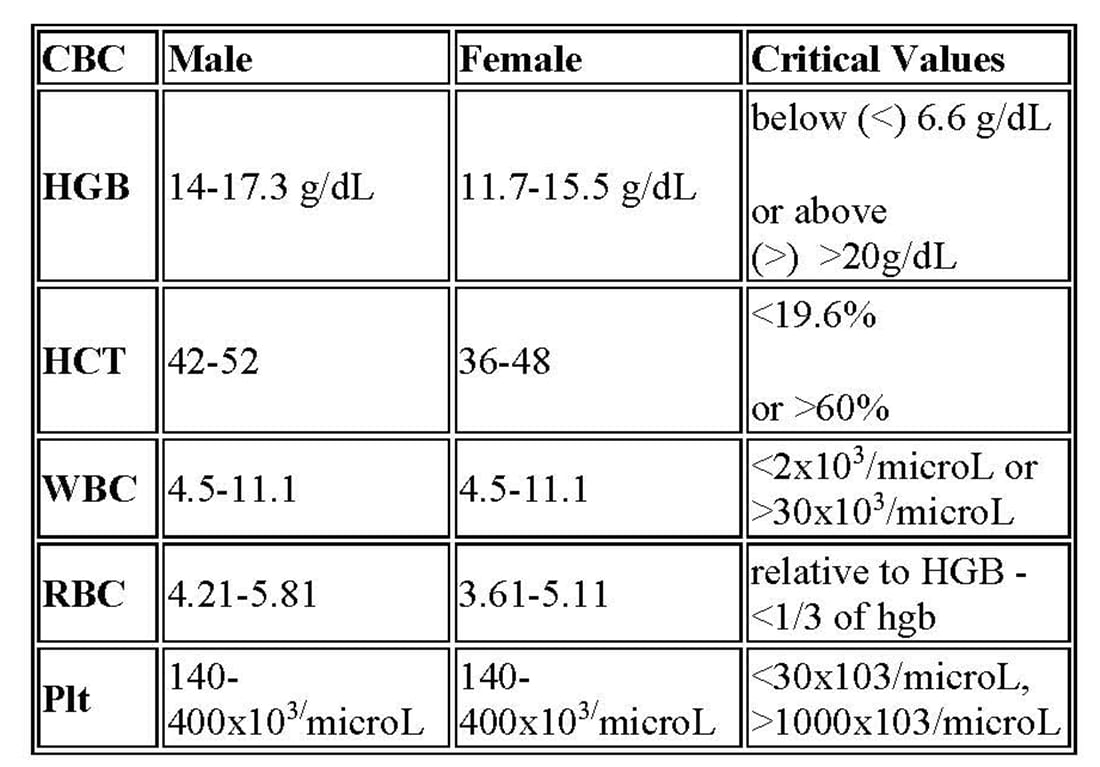CBC – Complete Blood Count
A Complete Blood Count (CBC) is one of the most common tests ordered. The test’s purpose is to check the count of all the cells in your blood and identify how many are present. A CBC includes a count of the red blood cells, white blood cells, platelets, hemoglobin, and hematocrit levels. If the doctor asks for a differential, it will also include a count of the immature cells present at each development stage.
Red Blood Cells
Red Blood Cells – (RBC) Normal range 4.2 -6.1 x1012/L (also called erythrocytes) Are produced by the bone marrow and live about 120 days (4 months). Each RBC makes hundreds of thousands of hemoglobin molecules. Body tissues, liver, and spleen destroy RBC.
Hematocrit – (Hct) The hematocrit is a percentage of RBCs in the total blood volume (i.e., red blood cells floating around in the blood plasma). To determine the number of RBCs, they are separated from blood plasma and counted as a percentage of everything left over to determine how they compare. A low hematocrit indicates fewer RBCs; a higher hematocrit means more RBCs.
White Blood Cells – (WBC) (also called leukocytes) Preferred range is 5.0 -10.0 x103. White blood cells are produced by bone marrow like RBC. Their job is to protect the body against infection. WBCs attack harmful organisms coming against us tries to destroy them, clean up the carnage after the battle, create antibodies to protect us from that enemy for the future, and stimulate the bone marrow to get us ready for the next fight! Increased levels of WBC indicate inflammation, infection, autoimmune disorders, or leukemia. A drop in levels indicates possible prolonged suppression of the bone marrow.
Platelets – Although bone marrow also produces platelets, they are different from red and white blood cells. Instead of keeping things moving along, the smallest of the three blood cell siblings has the job of clogging up the works. Unlike the white and red blood cells that keep blood flowing along, their little brother, platelet’s job, is to stick himself to any injured areas, form a clot, clump a group of clots together, and initiate the healing process. Platelets are produced by the bone marrow but stored in the spleen till needed. There are usually, 20% of our platelets in storage at any given time.
Hemoglobin – Hemoglobin is produced by red blood cells and uses iron to transport up to four oxygen molecules at a time. It also carries carbon dioxide, which helps to maintain the acid/base balance.
Understanding Lab Values Related to Blood Cell Counts

Column 1 = Element being measured
Column 2= Average value for healthy male
Column 3 = Average value for healthy female
Column 4 = Critical Value. The number that represents the dangerous levels a person can fall within

